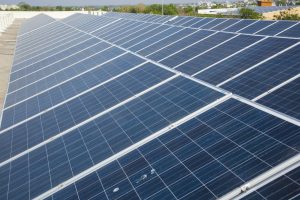China has long held a key position in the global electronics supply chain, from manufacturing of iPhones to home appliances. However, in recent years, some electronics manufacturers have diversified the geographic distribution of their production capacity in response to rising costs and geopolitical uncertainty, a trend that was accelerated by COVID-related supply chain disruptions.
The shift in manufacturing centers risks an unexpected consequence: a setback in electronics manufacturers’ climate ambitions. Amid their global expansion, electronics manufacturers must seek out renewable energy to power their manufacturing centers, including in Vietnam, India, and Mexico, rather than to lock these locations into fossil fuel dependence. Relocation of manufacturing should not be an excuse to delay global climate targets.
With the growth of artificial intelligence and the Internet of Things, emissions from electronics manufacturing are skyrocketing. Globally, chipmaking alone is on track to consume the equivalent to Australia’s total annual electricity consumption by the end of the decade. However, all too often, electricity demand from new manufacturing facilities is met by fossil fuels.
In recent years, the tech industry has found new opportunities to decarbonize. Apple and Google have already achieved 100 percent renewable energy across their own operations. In China, major tech companies have issued similar commitments, and Tencent and other industry leaders have committed to 100 percent renewable energy by 2030. In 2023, tech companies ranked among the biggest corporate consumers of renewable energy in China.
Yet as supply chains expand globally, electronics manufacturers have appeared to waver on their climate ambitions. In 2020, Foxconn, a major supplier to Apple, Microsoft, and Amazon, announced that it would move some of its production of iPads and MacBooks from China to Vietnam. In 2021, Foxconn said it had invested $1.5 billion in Vietnam, and the company subsequently announced hundreds of millions of dollars in follow-up investments.
However, unlike in China, where Foxconn has invested in renewable energy infrastructure and solar installations at its facilities, the company has not revealed any steps to increase its renewable energy ratio in Vietnam, according to Foxconn’s 2023 CDP disclosure. The disclosure includes no mention of rooftop solar installations or purchase of international renewable energy certificates (RECs) in Vietnam, measures that Foxconn could readily implement on its own.
While electronics suppliers may overlook the need to decarbonize as they relocate, in some cases, their new host governments are scrambling to meet their renewable energy needs.
In 2023, Vietnam’s government announced that the country would accelerate the development of its direct power purchase agreement mechanism, enabling renewable energy users to sign contracts with power producers as soon as July of this year. Vietnam’s government has also encouraged the installation of rooftop solar to provide businesses with greater access to renewable energy.
The responsibility to advocate for renewable energy infrastructure lies not just with governments, but also with the electronics manufacturers themselves. When companies expand to new locations, they have an opportunity to integrate a comprehensive renewable energy strategy into their relocation plan from the outset. Before settling on a manufacturing site, manufacturers should share their renewable energy demands with host governments and negotiate procurement opportunities.
Likewise, consumer tech brands like Apple, Microsoft, and Google should allocate resources for their suppliers to explore renewable energy potential at their new manufacturing sites. For example, in 2018, Apple launched its China Clean Energy fund, which aids its suppliers to invest in renewable energy projects. Similar initiatives are needed in growing manufacturing centers so that expansion of manufacturing capacity does not delay global renewable energy targets.
At this stage, global decarbonization is a question of will rather than feasibility. At COP28, 118 countries committed to triple their renewable energy capacity by 2030, a pledge that will require significant action across the corporate sector to achieve, including from tech companies.
As an industry of the future, it is critical that tech suppliers prioritize climate ambition. Tech giants Apple and Google have shown us that it is possible to achieve 100 percent renewable energy across their own operations worldwide, but their suppliers must follow. Electronics manufacturers cannot afford to let expansion into new manufacturing centers hinder their climate progress.

































